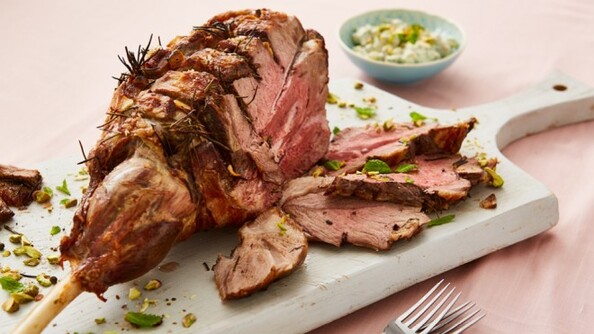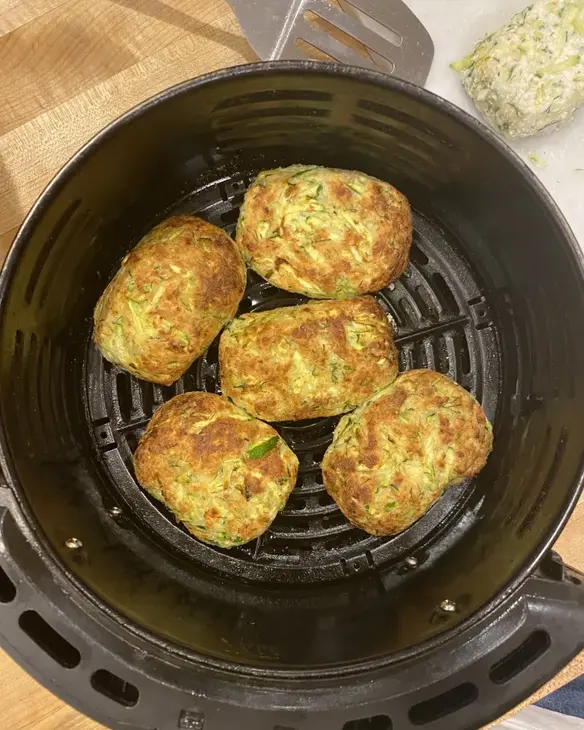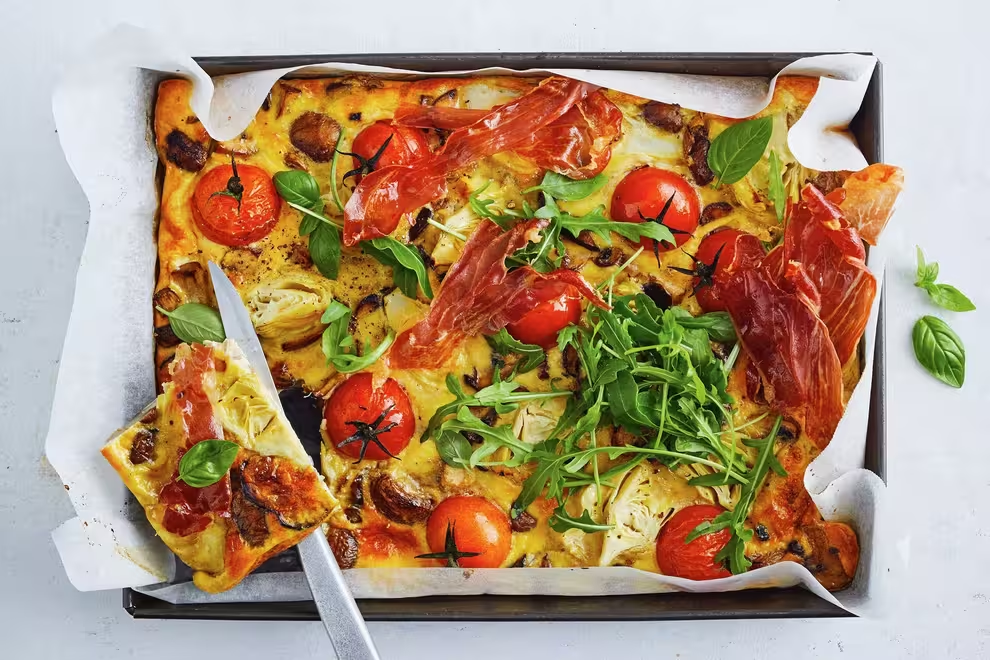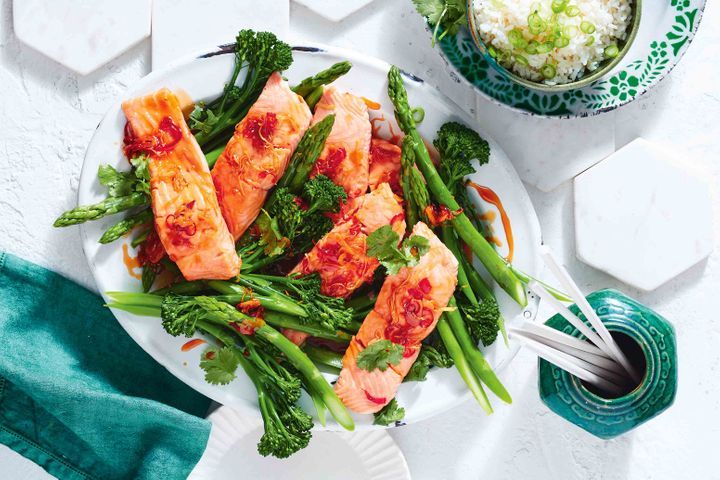Traditional roast lamb is a classic, comforting dish often served on special occasions or Sunday dinners. Its rich, savory flavors and succulent texture come from the slow roasting of high-quality lamb, seasoned with herbs, garlic, and spices. This dish is popular across various cultures, with each region adding its own twist, but the fundamentals remain similar. This recipe will help you master the perfect roast lamb with tender meat, crispy skin, and deep flavors.
Ingredients
To make a traditional roast lamb for a family meal, you’ll need the following ingredients:
For the Lamb Roast:
- 4-5 pounds (1.8-2.3 kg) bone-in leg of lamb (bone-in enhances flavor and moisture)
- 4-6 cloves of garlic, sliced thinly
- 2 tablespoons fresh rosemary, chopped finely (or 1 tablespoon dried rosemary)
- 1 tablespoon fresh thyme, chopped finely
- 1 tablespoon fresh oregano, chopped finely (or 1/2 tablespoon dried oregano)
- 1 tablespoon salt
- 1 tablespoon black pepper, freshly ground
- 3 tablespoons olive oil
- 1 tablespoon lemon juice
- 1 cup beef or chicken broth (for added moisture and flavor while roasting)
For the Vegetables (Optional):
- 4 large potatoes, quartered
- 2 large carrots, chopped into thick slices
- 1 large onion, cut into wedges
- 2-3 sprigs of rosemary for additional aroma
Step-by-Step Instructions
1. Preparing the Lamb
Preparation is essential to ensure the lamb absorbs all the flavors and roasts evenly. Start with a quality cut of lamb, preferably bone-in, as this retains flavor and moisture.
- Remove from Refrigerator: Take the lamb out of the refrigerator about 1-2 hours before cooking to bring it to room temperature. This will help it cook more evenly.
- Trim Excess Fat: While lamb fat is flavorful, trimming some of the excess will prevent the dish from being overly greasy. Leave a thin layer for flavor and crispiness.
- Make Incisions: Use a sharp knife to make small, deep cuts into the lamb. Make about 15-20 cuts, spaced evenly over the meat. These pockets will hold garlic and herbs, infusing the meat with flavor.
2. Infuse with Garlic and Herbs
The key to a flavorful roast lamb lies in the seasoning, which should penetrate deep into the meat.
- Insert Garlic: Insert a garlic slice into each cut you made on the lamb, pressing it deep into the incision.
- Rub with Herbs and Seasoning: In a bowl, combine chopped rosemary, thyme, oregano, salt, and pepper with olive oil and lemon juice. Rub this mixture generously all over the lamb, ensuring it covers every part. The oil and lemon juice help tenderize the meat and add flavor depth.
- Marinate (Optional): For enhanced flavor, cover the lamb with plastic wrap and let it marinate in the refrigerator for 4-6 hours or overnight. If you’re short on time, a 1-hour rest at room temperature will still allow flavors to develop.
3. Preparing the Vegetables
Adding vegetables to the roasting pan creates a flavorful side dish and enhances the lamb’s flavor with aromatic notes.
- Chop and Season Vegetables: Arrange potatoes, carrots, and onion wedges around the roasting pan. Drizzle them with olive oil, sprinkle with salt, pepper, and a few rosemary sprigs, and toss to coat.
- Layering Tip: Place the lamb on top of the vegetables so the juices from the meat can drip down, infusing them with flavor.
4. Roasting the Lamb
The key to a succulent roast lamb is controlling the temperature and cooking time.
- Preheat the Oven: Set your oven to 325°F (160°C) for a slow roast. Lower temperatures allow the lamb to cook evenly and stay tender.
- Add Broth: Pour the broth into the pan, around the vegetables. This will keep the meat moist during the roasting process.
- Cover with Foil (Optional): For an ultra-tender lamb, cover the roasting pan loosely with foil for the first half of cooking. This helps lock in moisture.
- Cooking Times: Roast the lamb according to its weight and your desired level of doneness. For a 4-5 pound leg of lamb:
- Rare: Roast for approximately 1 hour and 30 minutes, or until the internal temperature reaches 125°F (52°C).
- Medium-Rare: Roast for 1 hour and 45 minutes, or until the internal temperature reaches 135°F (57°C).
- Medium: Roast for 2 hours, or until the internal temperature reaches 145°F (63°C).
- Well-Done: Roast for 2 hours and 30 minutes, or until the internal temperature reaches 160°F (71°C).
- Baste Regularly: Every 30 minutes, baste the lamb with the pan juices. This keeps the lamb moist and helps build a beautiful, crispy crust.
5. Finishing Touches
- Remove Foil and Increase Heat: About 15-20 minutes before the end of roasting, remove any foil and increase the oven temperature to 400°F (200°C) to crisp up the exterior. Watch closely to avoid burning.
- Rest the Lamb: Once done, remove the lamb from the oven and let it rest on a cutting board, tented loosely with foil, for 15-20 minutes. Resting allows the juices to redistribute, making the meat juicier.
Carving and Serving the Lamb
Carving the roast lamb properly enhances the dining experience. Follow these steps for beautifully sliced pieces:
- Identify the Bone Structure: Locate the bone within the leg of lamb, as cutting along the bone produces better slices.
- Slice Against the Grain: Use a sharp carving knife to cut against the grain of the meat, which helps create tender slices.
- Serve with Pan Juices: Drizzle some of the lamb’s pan juices over the slices for added flavor and moisture.
Pairing Suggestions and Side Dish Ideas
A traditional roast lamb pairs well with a variety of sides, sauces, and wines. Here are some pairing ideas to complete your meal:
Classic Side Dishes
- Roasted Vegetables: The potatoes, carrots, and onions from the pan are infused with lamb juices and make an excellent side.
- Mint Sauce: A fresh mint sauce or mint jelly complements lamb’s rich flavor beautifully, adding a touch of sweetness and freshness.
- Gravy: Make a simple lamb gravy using the pan drippings. Just add flour to thicken and season to taste.
- Steamed Greens: Simple steamed green beans, asparagus, or Brussels sprouts add color and freshness to the plate.
Wine Pairing
- Red Wine: Lamb pairs wonderfully with medium-bodied red wines. A classic pairing is Cabernet Sauvignon, Syrah, or Merlot. For a more regional option, try an Australian Shiraz or a French Bordeaux.
- White Wine: If you prefer white wine, opt for a fuller-bodied choice like Chardonnay, which complements the richness of roast lamb.
Tips for the Perfect Roast Lamb
- Choose Quality Meat: High-quality lamb will yield a more tender and flavorful roast. Opt for grass-fed if possible, as it often has better flavor.
- Use Fresh Herbs: Fresh herbs provide a more vibrant aroma than dried herbs. However, if using dried, remember that dried herbs have a more concentrated flavor, so use them sparingly.
- Cook to Temperature, Not Just Time: Use a meat thermometer to ensure your lamb is cooked to the desired doneness. Lamb can quickly go from tender to overdone, so accuracy is key.
- Let it Rest: Resting allows the meat to reabsorb its juices, preventing dry slices. This step is crucial for a juicy, flavorful roast.
- Experiment with Seasoning: Traditional herbs like rosemary, thyme, and garlic bring out the best in lamb, but don’t be afraid to try other flavors like smoked paprika, cumin, or a touch of chili for a twist.
Storing and Reheating Leftovers
If you have leftovers, roast lamb stores well and can be used in various dishes.
- Refrigeration: Store leftover lamb in an airtight container in the refrigerator for up to 3-4 days.
- Freezing: Wrap the lamb slices in foil, place them in a freezer-safe bag, and store in the freezer for up to 2-3 months.
- Reheating: Reheat lamb in the oven at 300°F (150°C) covered with foil to retain moisture. Alternatively, warm gently in a skillet with a little broth to keep it juicy.
Creative Ideas for Leftovers
- Lamb Sandwiches: Make hearty sandwiches with slices of lamb, arugula, tomatoes, and your favorite spread on crusty bread.
- Lamb Stew: Dice the leftover lamb and add it to a vegetable stew for a flavorful, comforting meal.
- Lamb Salad: Toss slices of lamb with fresh greens, feta, olives, and a lemon vinaigrette for a Mediterranean-inspired salad.
- Shepherd’s Pie: Use chopped lamb as the base for a shepherd’s pie topped with mashed potatoes and baked until golden.
Health Benefits of Roasted Lamb
The traditional roast lamb recipe offers several health benefits when prepared and enjoyed in moderation. Here’s a breakdown of the key health advantages:
1. Rich in High-Quality Protein
- Lamb is an excellent source of protein, which is essential for muscle growth, repair, and overall body function. Protein helps maintain a healthy metabolism, supports immune function, and provides satiety, helping to reduce unnecessary snacking.
2. High in Iron
- Lamb is naturally rich in heme iron, a form of iron easily absorbed by the body. Iron is crucial for red blood cell production, which helps transport oxygen throughout the body and supports energy levels, making lamb a good option for preventing anemia.
3. Source of Essential Vitamins and Minerals
- Lamb is packed with essential nutrients, including B vitamins like B12, niacin, and riboflavin, which support energy production, brain health, and cell repair. Lamb also provides zinc, selenium, and phosphorus, minerals that aid immune function, bone health, and cellular repair.
4. Healthy Fats in Moderation
- While lamb contains some saturated fat, it also has healthy monounsaturated and polyunsaturated fats, which can help improve cholesterol levels. Moderating portion sizes and trimming excess fat can reduce saturated fat intake while still enjoying lamb’s flavor and nutrients.
5. High in Conjugated Linoleic Acid (CLA)
- Lamb is one of the best natural sources of CLA, a beneficial fatty acid that has been linked to improved heart health, reduced inflammation, and better body composition. CLA may also support metabolism and immune function.
6. Supports Bone Health
- The calcium, phosphorus, and protein in lamb support strong, healthy bones. Including lamb in the diet, along with other calcium-rich foods, may help protect against osteoporosis and bone loss as you age.
7. Balanced Nutritional Profile with Vegetables
- When paired with roasted vegetables like carrots, potatoes, and onions, this roast lamb meal provides a balanced profile of vitamins, minerals, fiber, and antioxidants. The vegetables offer vitamin C, potassium, fiber, and beta-carotene, supporting heart health, immune function, and digestive health.
8. Rich in Antioxidants from Herbs and Garlic
- Fresh herbs like rosemary, thyme, and oregano, along with garlic, add antioxidants to the meal. Antioxidants help reduce oxidative stress, inflammation, and may support heart health. Garlic is particularly known for its immune-boosting and heart-protective properties.
9. Supports Weight Management and Satiety
- The protein content and balanced fats in lamb, combined with fiber-rich vegetables, promote satiety, which helps in controlling appetite. A balanced meal like this one may help in weight management by keeping you full longer and reducing cravings.
10. Good for Muscle Maintenance
- High-quality protein in lamb supports muscle maintenance, which is particularly important as we age. It can be beneficial for athletes and those looking to build or preserve lean muscle mass.
Bottom Line
A traditional roast lamb is an unforgettable meal that brings warmth
and comfort to any gathering. This recipe combines simple ingredients and techniques to create a deeply flavorful dish that highlights the natural richness of lamb. Whether it’s for a festive occasion or a cozy family dinner, roast lamb is a timeless dish that will be enjoyed for years to come. With the right preparation and a touch of patience, you’ll have a perfectly roasted lamb that’s sure to impress.




